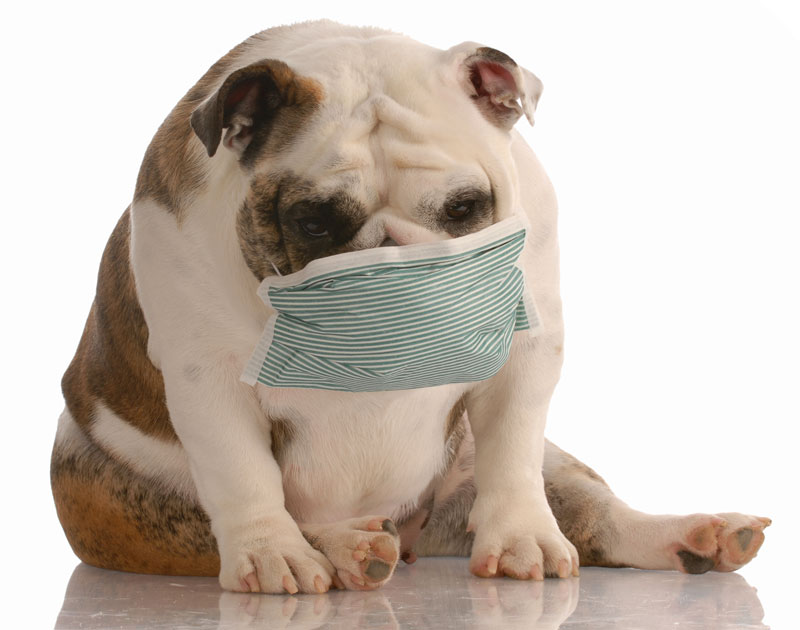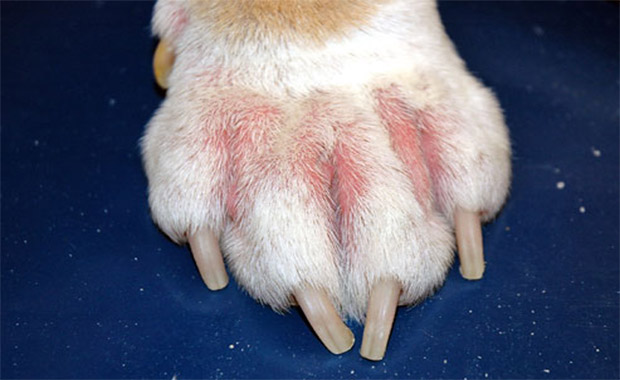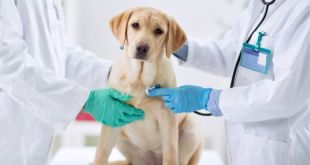Similar to humans, dogs also get allergies when their immune system is compromised towards certain allergens. Skin allergies are one of the most common types of allergies in dogs. Sometimes it is hard to determine the cause behind an allergic reaction and you can’t always avoid the cause.
However, you can figure out the reason behind an allergic reaction and take precautions to manage or control the symptoms.
Symptoms of skin allergies in dogs:
- Constant itching
- Inflamed skin with severe itching
- Dog chewing at affected areas
- Itching at rump and base of the tail
- Hair falling out in patches
- Skin getting dry and scaly
- Continuous belly and paw licking
- Ear infection
- Face rubbing
- Rash – small red bumps and raised patches of skin
- Nasal discharge
- Sneezing
There are predominantly 4 types of allergies that dogs suffer from:
Flea allergy
Flea allergy is the most common type of all dog skin allergy. A flea allergy does not mean that your dog is infested with multiple fleas, in fact, if your dog is allergic to fleas he will react to just one flea bite.
It is believed that it is not the bite of a flea that causes the most itching, it is the saliva of the flea that causes it. The most common indicator of your dog suffering from a flea allergy is when your dog starts to bite and scratch at its rump area near the base of his tail. This type of allergy mostly happens during the warmer months and spring season.
To prevent any further contact with fleas, do not let them play in grass or sand outside for a few days or weeks, and vacuum your carpets and interiors to make your home free of fleas.
Diagnosis
To check if your dog has a flea allergy, make them stand on a white sheet and comb their fur. If you see white or black grains of a sandy material drop onto the sheet, you have found fleas.
A vet can easily recognize a flea allergy by conducting an intradermal skin test, but this is usually not necessary. If you find any evidence of fleas or a flea allergy, you can treat it without a vet visit too.
- Comb your dog regularly with a flea comb, especially during summers and humid seasons. Do this on a white towel so that you can see if any flea falls off of your dog’s fur.
- Give a medicated bath with Benadryl. It will kill all the fleas and soothe skin irritation.
- Use other medications like Advantage, Advantix, Frontline Plus, or Vectra 3D to treat.
- Use an organic pest repellent product like “Natural Flea and Tick defense” during flea season.
Inhalant allergy
Inhalant allergy is known as Canine Atopy/Atopic Dermatitis. These are also called air-borne allergies and happen due to inhalation of allergens such as wild grass, dust mites, molds, and pollens, etc. Dogs have different reactions to allergies such as itching, scratching, skin biting, chewing of the paws, and constant licking. This kind of allergy can hit dogs at any age, it’s mostly found in dogs aged 1-4 years.
Diagnosis
A clue to diagnosing this type of allergy is to find the exact time or period when the allergic reaction took place. It is also imperative to keep a note of whether this happens every season or not. You can easily deduce from the timing of the reaction whether it is due to mold, dust, or pollens that are seasonal occurrences.
There are two types of tests that you can ask your vet to perform to know about the type of allergy your dog is suffering from – blood test and skin test. These tests will help you learn what your dog should avoid or requires less exposure to.
Here are a few things you can do to cure your dog’s allergies at home.
- Regular medicated baths can calm the itching.
- Clean up your pet’s indoor environment, switch to non-toxic cleaning products.
- Don’t smoke or allow smoking around your pets.
- Keep pets in a room where the floor is not covered with carpet.
- Trim down the grass on your lawn.
- Use a plastic cover over their beds to avoid dust mites.
Food allergy
It is the third most common cause after flea and inhalant allergy. If your dog has an allergy to something they’ve been eating, they will show symptoms such as excessive gas passing, diarrhea, vomiting, etc. They may also show some other symptoms like blood-red eyes, coughing, sneezing, itching, inflamed ears, etc. Most dog food allergies are related to natural food products such as milk, egg, meat, grains, fish, corn, wheat, and soy.
Diagnosis
Unlike inhalant allergies, food allergies cannot be diagnosed with blood and skin test. The only way to diagnose a food allergy is by conducting a novel food trial. It is a combination of protein and carbohydrate diets that the dog never had before.
Try switching to a premium brand dog food product. If you begin to see relief in the dog’s symptoms, it means your dog had a severe food allergy from the previous foods you were providing. Consult a vet immediately and get them checked properly.
Contact allergy
A contact allergy is also known as Contact Hypersensitivity or Contact Dermatitis. It simply means that your dog has come in contact with something that is causing irritation to its skin. It is vital to find the real cause of this type of allergy. Try to relieve your dog’s daily routine to figure out the cause of Contact Dermatitis.
It could be a plant like poison ivy or salt on the road, shampoos, carpet cleaners, room fresheners, fabrics, fertilizers, rubber, etc. The symptom will be rashes or bumps on the affected area. You have to check their chin, chest, neck, groin, anal area, etc.
Diagnosis
There are several ways to find out what caused your dog’s allergy. You can figure it out on your own or you can consult your vet too. Veterinaries usually do a patch test to check if the dog’s skin is reacting to a particular thing or not.
Now that you know about the most common skin allergies that affect dogs, you can prepare, educate and take precautions. Keep a clean environment for your dog and you’ll be able to avoid all major allergic reactions that happen in canines.
Want to read more articles like these? Subscribe to our newsletter today!
 DogExpress
DogExpress






















 in Chandigarh, India.
in Chandigarh, India. 

